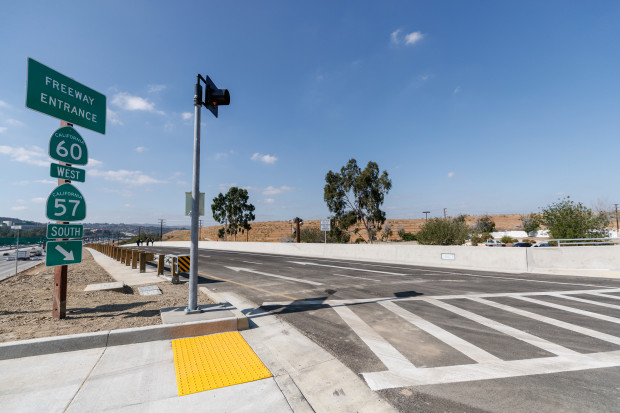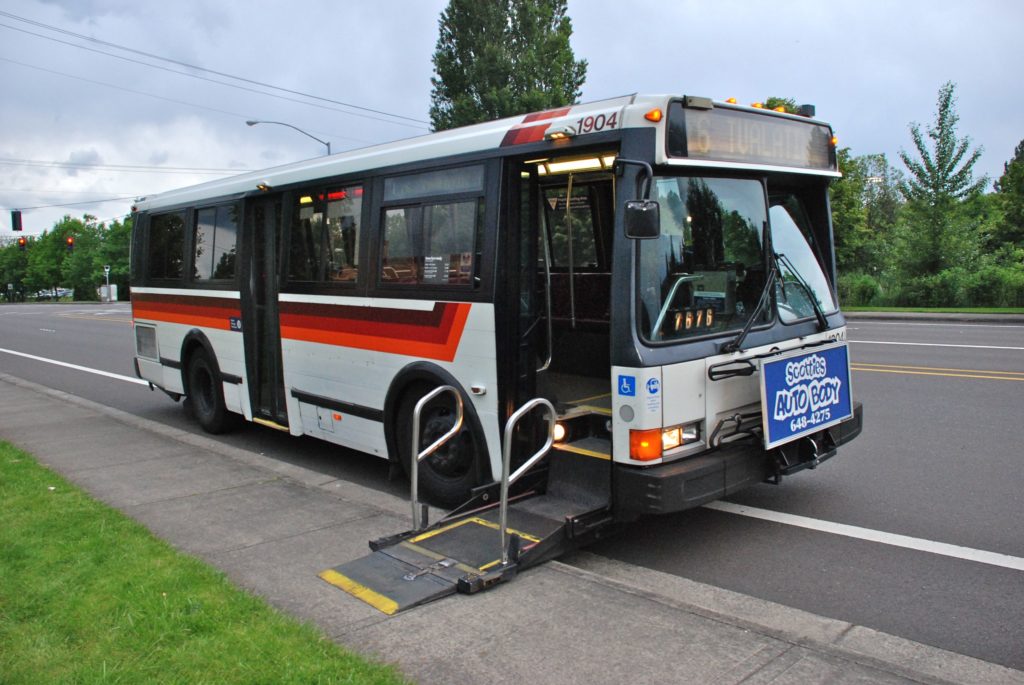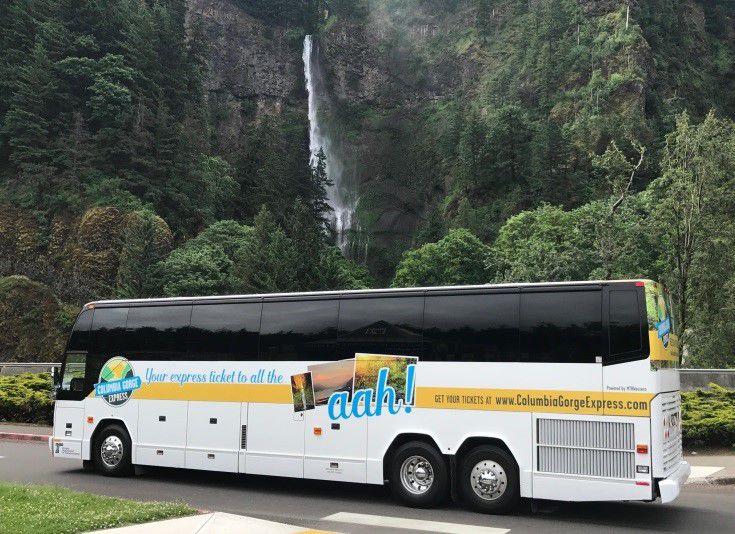Let’s require that highways really be accessible to those who can’t drive: State highway departments should provide bus service on state roads for the disabled
The Americans with Disabilities Act was landmark legislation to make sure that the disabled were not denied equal access to the public realm. The ability to travel freely is an important part of accessibility, and the ADA has made considerable progress in making public buildings, restrooms, city sidewalks and transit vehicles easier for the disabled to use. Highway departments have generally been laggards.
For example, fewer than 3 percent of the sidewalk ramps along Oregon highways comply with the requirements of the American’s with Disabilities Act (ADA), according to a recent report. The lack of ramps is a major mobility issue; state highways are often main streets of smaller towns, and these key bits of infrastructure are critical go giving everyone equal access to their communities and not being halted by barriers.” After threatened legal action, the Oregon Department of Transportation has agreed to start spending several tens of millions of dollars each year to build ramps. With luck, the department hopes to have the backlog addressed by 2032.
Here’s an example (from California) of the kind of ADA compliance we’re talking about.

There’s a ramp that connects the sidewalk on one side of the freeway on-ramp to a similar ramp on the other side of the freeway on-ramp. Notice that this doesn’t actually make the freeway “accessible” to a disabled user–it simply makes it slightly less likely that they will be killed or injured trying to cross the freeway on-ramp. Such ramps don’t make it possible for the disabled to “use” the freeway, so much as to make it slightly less hazardous when they actually don’t use the freeway. Even with the ramps in place, it’s still the case that its both physically impossible or simply illegal for a disabled person to use the freeway itself for its intended purpose (traveling from one point to another) unless they have a car and someone who can drive it for them.

So while the settlement making these crossings somewhat less pedestrian-hostile is definitely a positive step, we think it might be a good idea to go further. All the ADA requires now is that those who can’t drive a car have a safe way to cross a road without one. But its still the case that if you don’t own or can’t drive a car, there’s no way for you to use a state highway, unaided, for its intended purpose–getting from one part of the state to another. The highway is only usable by those with the physical wherewithal (and financial resources) to operate a vehicle (usually a car, but in many places, bikes as well).
In contrast, look at how the American’s with Disabilities Act applies to transit providers. There’s a wide disparity between how ADA requirements affect transit agencies as compared with highway departments. Not only do transit agencies bear the cost of retrofitting transit vehicles with wheelchair ramps and kneeling capability, but most also operate complementary on-demand or dial-a-ride services for those with disabilities. As long as you’re want to travel in a transit agency’s service area, they’re generally required by ADA to provide such services.

These paratransit services are expensive. Portland’s transit operator, Tri-Met, spends about $35 million annually for its LIFT and cab services, providing slightly more than one million rides at a cost of more than $30 per passenger, almost 10 times the cost per passenger of its fixed route transit services (Tri-Met Proposed Budget, FY2016, Exhibits 5 and 6). Fares cover about 4 percent of total LIFT costs, meaning that more than 95 percent of the costs of this service are subsidized from other sources.
There’s a profound double-standard in the ADA when it comes to transportation. Bus companies have to provide separate vehicles for those who can’t use buses or trains, but highway departments have no similar obligation to make provide vehicles to those who can’t drive.
The point of these expenditures is to assure that the destinations served by the transit system are equally accessible to all citizens regardless of their disability status. The same standard, of course, doesn’t apply to highways. If you can’t operate a vehicle due to a disability, the destinations served by the highway system are inaccessible to you, but the state Department of Transportation provides no auxiliary service to those who can’t operate vehicles.
A modest proposal: have the highway department provide vehicles for those with disabilities
The Americans with Disabilities Act, passed in 1990, was a major expansion of rights for the nation’s differently abled citizens. It generally provides that in employment, and in the public realm, governments, employers and landlords have to provide reasonable accomodation for those who are disabled.
The ADA has led to a wealth of changes in the way buildings, streets, and bathrooms are designed. Cities are rebuilding sidewalk intersections with wheelchair ramps. Parking lots regularly set aside the most convenient parking spaces for use by the disabled. Bathrooms have wider stalls and lower sinks to accomodate those with limited mobility.
But highways, particularly our interstate freeway system is legally inaccessible to those with disabilities. In most states, its simply against the law to walk (or use a mobility aid) to travel on an interstate freeway. Millions of Americans, due to disability (and also due to age) are legally or practically barred from making independent and equal use of the taxpayer supported highway system.
According to the US Department of Transportation more than 25 million Americans have travel-limiting disabilities. Of those with such disabilities, fully 40 percent (or roughly 10 million) are unable to drive.
What we’d propose is extending the ADA to require that highway departments offer passenger vehicle service (like buses or ride hailed cars) to provide access to state highways for everyone. If you have a state highway that connects Portland with Salem, and it is really going to be “accessible” to the disabled, then the state ought to provide transit or some form of dial-a-ride service for those who are so disabled that they can’t operate their own vehicle. On lightly traveled routes, the highway department might subsidize vans; on larger roadways it could subsidize scheduled bus service.
That’s not entirely unimaginable. Already, the Oregon Department of Transportation runs bus service from the Portland area to Multnomah Falls to reduce traffic congestion to this tourist attraction. The agency could just as easily contract for bus service along interstate routes and major state highways.

If highway departments were required to act with anything approaching the same degree of responsibility to disabled citizens who are unable to use the freeway system, they would provide a wide-ranging system of scheduled buses and on-demand vehicle services. It’s worth asking how that might be paid for. Again, applying an analogy to the transit system, highway departments could charge users of buses or dial-a-ride alternatives exactly the same they charge freeway users: the combined per gallon gas tax paid by a typical car works out to about 2-3 cents per mile of vehicle travel, so it would be entirely fair to have the disabled pay an equivalent amount for their access to the system as well.
If we’re serious about giving the disabled equal access to the public realm, they ought to be able to travel on the expensive roadway system we’ve built that is so vital to connecting to almost every aspect of modern life. Ours is really a modest proposal that the agencies operating the nation’s highways provide the same accomodation to the disabled that the nation’s transit operators have provided for decades.

